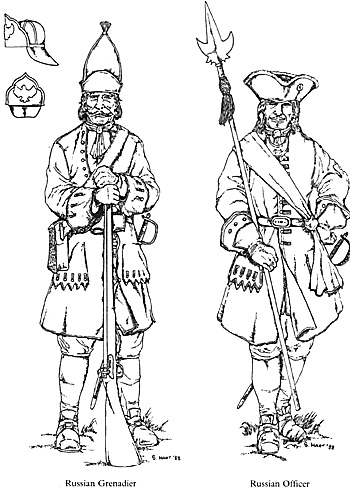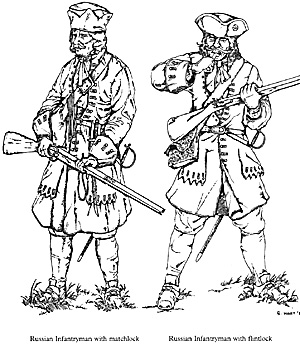 WEAPONRY
WEAPONRY
Like their opponents, the Swedes, the Russian foot were armed with both musket and pike. Why the latter was included in Peter's "modern" army is open to debate. It may be that the Tsar based his organisational models upon the practice of the armies of the late seventeenth century, when the Queen of Weapons was still seen in appreciable numbers on the battlefield. Again, it may be that the pike was retained in an attempt to stop the fury of the Swedish mounted charge carrying all before it. Probably a more practical answer is that equipping the army fully with muskets would have overstretched the capacity of Russian munitions factories! Whatever the reason, it would seem probable that perhaps one in three or four of the Russian foot was armed with pike, and that this ratio decreased and increased respectively depending upon whether the unit was a frontline regiment, or militia.
The "shot" of a regiment were equipped with a smoothbore musket. Many regiments up to 1710, and probably even beyond were equipped with matchlock muskets - a design which though less sophisticated than the flintlock was easier to build and maintain. In all probability, both matchlocks and flintlocks would have appeared in the same regiment's ranks. What effect this would have had on attempts to drill can only be imagined. One contemporary military innovation was taken to heart as each regiment had a large contingent of Grenadiers. These gentlemen would almost certainly have used flintlocks, and in addition carried up to three grenades each. So struck with this idea were the Russians that they eventually raised whole battalions of grenadiers.
Russian Grenadier
The illustration depicts a grenadier of a line regiment. The features which distinguish him from his fellows are his mitre cap and his outsize cartridge pouch, which contained his grenades. The flintlock musket has a sling attached, enabling the grenadier to have both his hands free whilst flinging his grenades. As the cartridge pouch was filled with grenades, a smaller pouch was carried attached to the front of the waist belt to hold ammunition supplies.
The grenadiers of the Semionevski and Praeobrajenski guard regiments wore a distinctive black leather helmet as depicted in the detail. This was trimmed in gold, and bore an imperial eagle in gold on the front. The Praeobrajenski had an oval plate bearing a crowned cypher on their cartridge pouches, whilst the Semionevski had the doubleheaded eagle in the centre, and four grenades in the corners.
Russian Officer of Foot
Until 1720 , Russian officers remained unregulated in their dress, and although an individual may have decided to wear the same coat colour as his men, this was left to personal choice. Whatever colour was chosen, the coat would have been decorated according to the wearer's taste, (and wealth), with metallic braid on seams and cuffs. The officer depicted carries the usual signs of officer status, namely a gorget, sash and pole arm. The sash was striped along its length in three broad bands of colour, in red, white and blue.
Although distrusted by the xenophobic native Russians the best officers were Germans, or immigrants from the Baltic provinces. Indeed a large number of foreigners were to be found in the Tsar's armies, including many Scots.
ORGANISATION
It is obvious that Peter had a firm idea of how he wished his army to be organised. He issued several series of regulations during his reign. However, the size of his army, allied to its chronic lack of both equipment and good officers meant that the difference between regulation and actual practice was always likely to be a large one. The following table sets out how Peter wished to see his army organised at different points during his reign:
- 1) In each case, the regulation allowed for two regimental artillery pieces.
2) Each regiment would normally operate as two battalions on the battlefield.
3) The 1708 regulations assumed that grenadiers would be taken from their parent bodies and brigaded. judging by the later regulations, this does not seem to have been a great success.
TACTICS
On the whole, the tactics adopted by the Russian Foot were conservative and simple. In line of battle, a battalion would form up four ranks deep, with the pike massed in the centre around the colours, and the grenadiers posted on the extreme flanks. Condray suggests that the Russian foot would have used the tactics of the French forces of the period, which seems likely in view of the essential conservatism of Russian military practice. This would have meant either volley-firing conducted one rank at a time, or a more conventional single all-rank volley. Neither of these was particularly effective in terms of fire control, never producing an adequate volume or reserve of fire. The platoon firing of the Maritime Powers' armies seems to have been unheard of.
| YEAR | MEN PER COMPANY | NO OF LINE COMPANIES | NO OF GREN COMPANIES | TOTAL NO OF MEN |
|---|---|---|---|---|
| 1699 | 100 | 10 | 1 | 1000 - 1350 |
| 1704 | 135 | 8 | 2 | 1350 |
| 1708 | 150 | 8 | 2 | 1200 |
| 1711 | 150 | 8 | 2 | 1500 |
| * excluding Grenadier Companies | ||||
UNIFORM AND EQUIPMENT
 In line with his other reforms, Peter attempted to bring a "Western" appearance to his armies, thus marking the advance into a new era. As a result, the troops adopted a full-skirted coat with large turned-back cuffs, thus presenting a similar overall appearance to their fellows in the rank and file of other European armies. However, nothing was ever straightforward about supplies to Russian armies in this period, and this included their uniforms.
In line with his other reforms, Peter attempted to bring a "Western" appearance to his armies, thus marking the advance into a new era. As a result, the troops adopted a full-skirted coat with large turned-back cuffs, thus presenting a similar overall appearance to their fellows in the rank and file of other European armies. However, nothing was ever straightforward about supplies to Russian armies in this period, and this included their uniforms.
The coat was to have been of a standard cut, with two horizontal front pockets. A distinctive "Russian" addition soon appeared, with the adoption in many cases of pocket flaps cut into "crenellations". Having said that, other more conventional types were also in widespread use. Underneath the top coat was worn a waistcoat, often in a contrasting or facing colour. The top coat appears to have been left unbuttoned to the waist, thus exposing the waistcoat below. Breeches and knee socks worn in western style completed the outfit. The headgear was either a tricorne, usually laced yellow, or a unique Russian item, the "Pokalem".
This was a lined cap similar in many ways to the Swedish "Karpus", with flaps which could be turned back to expose a coloured lining, or pulled down to protect the wearer's extremities from cold and inclement weather.
It should be noted that the above describes the desired effect rather than the actual result, and to imagine a Russian regiment, especially in the early years of the war, to consist of about a thousand men in uniform coats, cut to the same pattern, and dyed the same colour is far from the truth. Difficulties with supply would see a wide range of styles, colours and headgear, and despite the steady improvements made during the struggle, it was only towards the very end of the war that the Russian field armies could be seen in proper uniforms. The appendix showing known uniform colours demonstrates this perfectly.
Russian Infantryman with Matchlock
In common with many European armies at the turn of the century, Russia had troops armed with out of date matchlock muskets. However, the weapon seems to have been used in larger quantities and for longer than in more forward looking forces.
The figure depicted is wearing the "Pokalem" hat. This was often lined with cloth of a contrasting colour, occasionally matching the combination of coat colour and facing colour of the uniform coat. However, as with most things in the Russian army of this time, a large amount of variation inevitably crept in.
Russian Infantryman with Flintlock
This soldier could be a member of the same regiment as the previous figure. He differs only in two main respects. Firstly he is using the more modern flintlock musket, and secondly he is wearing the more conventional three cornered hat.
The type of uniform and equipment depicted was originally worn by the Pracobrajenski and Semionevswki Guard regiments, which came to form the pattern for the Russian army as a whole.
The distinctive moustache depicted seems to have been "de rigeur" for all Russian troops, no doubt modelled upon Tsar Peter's own facial growth.
The 1720 decree defined what was to become the standard Russian uniform, and was based directly upon the uniforms of the Pracobajenski guards. The coats were dark green, with red collars and cuffs. Waistcoat and breeches were also red, and stockings white. The pokalem was banned, headgear instead to be the tricorne, laced with yellow.
Officers wore coats of better quality than their soldiers, and were marked by the usual paraphernalia of gorget, polearm and sash. This latter item was striped along its length from top to bottom, red, white and blue.
There were two guards regiments, the Pracobajenski, and Semionevski. These formations dated from the earliest years of Peter's reign, being originally the units used by the young Tsar to practice with different ideas of Western European warfare. The Guards were uniformed from the start, the Praeobajenski being clad in green coats with red collars and cuffs, and green waistcoats, breeches and stockings, whilst the Semionevski wore light blue coats with red collars and cuffs, blue waistcoats and breeches and green stockings. Both formations adopted the tricorne rather than the Pokalem, while the grenadier formations wore a distinctive black leather helmet rather than the mitrestyle of their line colleagues.
Both of these regiments were larger than their line equivalents, being able to field up to four battalions. In the face of evidence to the contrary, the normal ratio of Pike-MusketGrenadiers seems to have applied, as well as the provision of regimental artillery pieces.
More GNW Uniforms: Russia
Back to 18th Century Military Notes & Queries No. 10 Table of Contents
Back to 18th Century Military Notes & Queries List of Issues
Back to Master Magazine List
© Copyright 2001 by Partizan Press
This article appears in MagWeb (Magazine Web) on the Internet World Wide Web.
Other military history articles and gaming articles are available at http://www.magweb.com